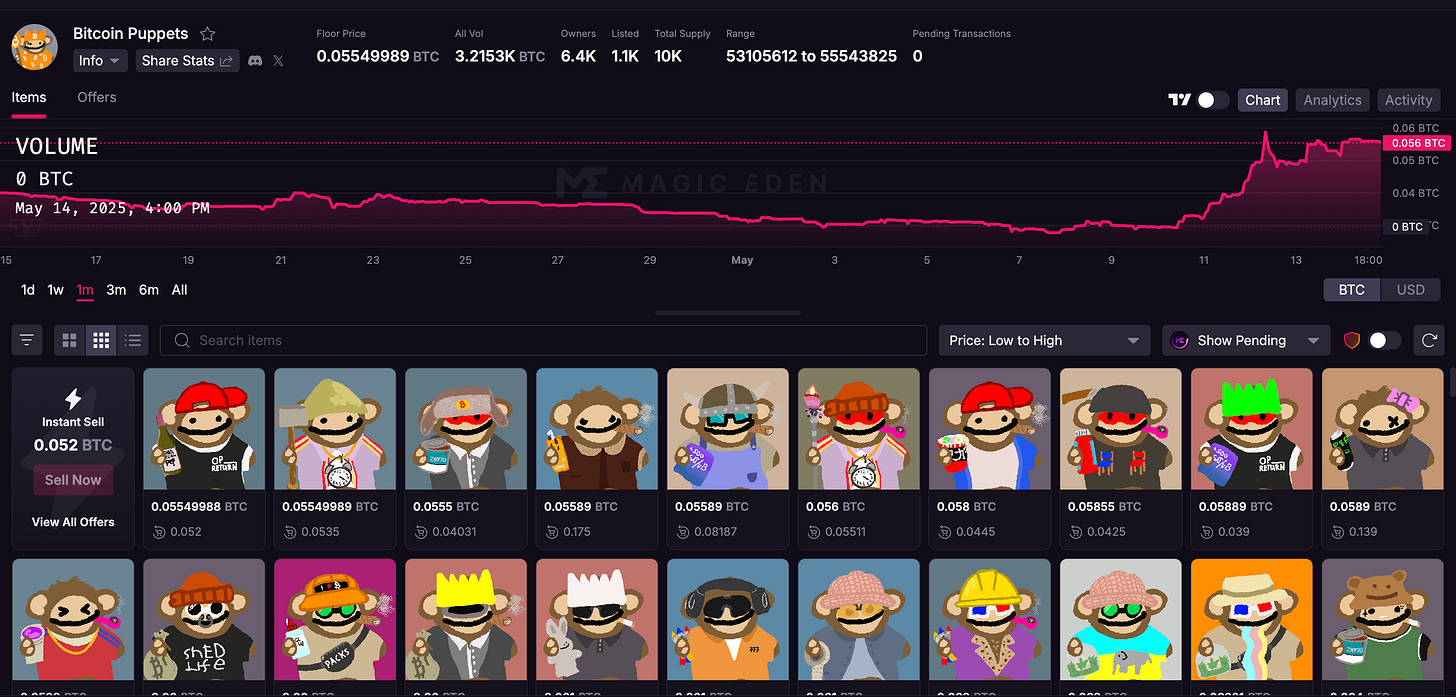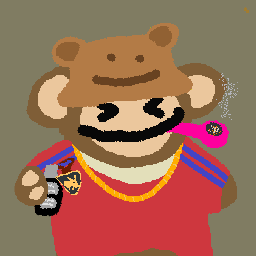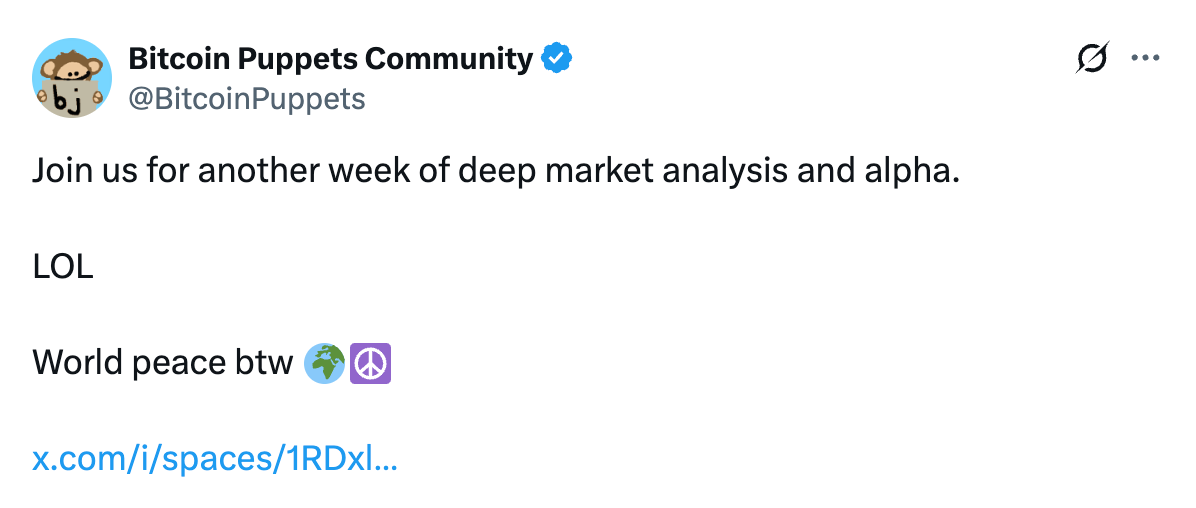The Bitcoin Puppets (and their impact on crypto culture)
The Bitcoin Puppets community is weird and the project's history is confusing. So let's unpack it.

Origins of Bitcoin Puppets
The Creator: Le Puppeteer Fou
The Bitcoin Puppets were originally conceived by Le Puppeteer Fou, a pseudonymous artist with a background in abstract portraiture and prior NFT projects. Before Bitcoin Puppets, The Puppetmaster created Lasogette on Ethereum and O.P.I.U.M. on Bitcoin - both of which are done in a playful, esoteric style, similar to the Puppets’ aesthetic. The creator’s anonymity added to the project’s mystique, aligning with the decentralized, leaderless ethos of Bitcoin itself.
The Bitcoin Puppets collection consists of 10,001 profile picture NFTs, reportedly hand-drawn in Microsoft Paint by a 12-year-old. The art is deliberately simplistic, featuring monkey-like puppets with messy, pixelated designs and crypto-specific in-jokes. Examples of traits include:
Two chairs t-shirt: a nod to Michael Saylor’s Bitcoin maximalist rhetoric, “How many chairs are you sitting on?” with red and blue chairs referencing The Matrix’s red and blue pills.
Pink pipe: a tribute to BennyTheDev’s PIPE protocol, playfully dubbed “trac pipe” (a riff on “crack pipe”) by community members.
Lamborghini car key: a reference to the 2021 crypto meme “wen lambo” where degens would join Telegram chats and spam the phrase until they got banned.

A lot of normies would say the puppet above ugly. But puppet holders love the early internet nostalgia, which contrasts with the the polished designs of many Ethereum-based NFTs. And because the collection is released under a Viral Public License (VPL), it has spurred fan creations and expanded its own cultural footprint.
Their Mass Appeal
Despite the exciting new project on the then-new ordinals technology, a few problems remained:
The project didn’t have a team.
The project didn’t have a roadmap.
The project had no… real point?
Well, actually, it sort of did have a point.
If you think about it, in the grand scheme of crypto, most NFT projects exist simply to extract money from speculative gamblers and transfer it into the pockets of tech bros. So, in fact, the lack of a centralized backer and any marketing effort was reason enough for many to pay attention to Puppets.
Along with the project’s launch, a Puppet manifesto was inscribed onto the Bitcoin blockchain. It detailed the Puppet ideology, which we can summarize with a single excerpt:
Puppets are the pinnacle of crypto culture because they live on the edges, hiding in the shadow fringe on the chain that started a revolution in finance and self-organizing economic communities, not bounded by any authority. We swirl in a frenzy of laughter screaming that puppets will go to zero because we know that on a long enough timeline, everything goes to zero, even your precious fiat dollars. Along the way, whether you lose it all, or make it all, the only thing you can really do is laugh. We’re not crazy, we’re just ahead of the curve.
This internet centric, NEET-oriented, cult-like rhetoric resonated with many long-time crypto people - again, because of its contrast with crypto’s over-commercialized ecosystem, throwing people back to the grassroots, anti-bank movement that spurred Bitcoin’s popularity in the early 2010s.
But this unusual approach to an NFT launch created lots of online turmoil. Fans and holders embraced the art’s absurdity and the community’s anti-corporate stance, while critics dismissed it as low-effort, speculative, and exploitative of the crypto mindset. This polarity fueled engagement, with early adopters doubling down on their support and detractors lurking on platforms like Twitter. The manifesto, championing “artistic absurdity, economic nihilism, and world peace,” became a rallying cry for its community.
The Puppets Community
Puppet subculture is still thriving today. The community is generally described as “severely unhinged,” but also deeply passionate about personal economic freedom. The appeal to absurdity and shared disdain for the traditional lifestyle serve as surprisingly strong bonding agents. Members tend to largely overlap with the NEET crowd, Housecoin crowd, and even the blackpill crowd to some extents. Generally speaking, Puppet holders hate societal structure and love the irony of magic internet money.
On Reddit, users sometimes compare Bitcoin Puppets to other absurdist ordinals like Bitcoin Frogs, arguing that they only appeal to “glue victims and crayon eaters” and those with mental issues. Holders’ undying passion for the Puppets project has even been likened to “4chan finding a Bloomberg Terminal” - which is a somewhat interesting thought.
Puppets have become a cultural symbol in the NFT space, and are often compared to CryptoPunks for their iconic and recognizable imagery. They’re widely used as profile pictures on social media (here’s mine) as a direct nod to Bitcoin’s original vision of having no inherent value while being a slap in the face to banks. If you’re on Twitter, then you might even know that ending a tweet with the phrase “world peace 🌎 ☮️” is a signal that you’re in-the-know of the Puppets.

The project’s emphasis on playful rebellion has inspired memes, merch (t-shirts, hoodies, etc.), and even real-world meetups at events like ETH Denver, NFT.NYC, and Bitcoin 2024 in Nashville. The collection’s open licensing has led to derivative projects, fan art, and collaborations, creating a self-sustaining creative ecosystem. All in all, a pretty fun group of people to interact with.
Impact on Crypto Culture
Puppets have pushed NFT culture back in the right direction, reminding us that digital jpegs are just that - memes that appear on your screen from time to time. They’re not smart investment vehicles, and are only worth as much as their communities.
But even in their absurdity, the Puppets are here to stay. Similarly to other projects like Milady Maker, the Puppet community has established its foothold in crypto through its persistent online presence. This has even driven many online analysts to label Bitcoin Puppets as a potential blue-chip collection like NodeMonkes. (which is high praise)
Beyond the main collection, Bitcoin Puppets has spawned derivatives like Rune Pups, airdropped in March 2024, and is unofficially connected to the $PUPS meme coin, launched as a BRC-20 and later bridged to Solana as an SPL token. This integration, despite separate developments, has broadened participation and reinforced community ties. In May 2025, The Puppetmaster announced Ord Puppet Inu, a 777-supply collection, further expanding the ecosystem.
Back to Reality
Bitcoin Puppets’ market performance has been generally strong, with a floor price peaking at 0.44 BTC (~$30,000) in April 2024 and a market cap of $112M in January 2025. Today, they’re down a bit, but that’s no biggie.
Despite volatility, the community has continued to drive engagement; controversies have been overshadowed by cultural impact; even Cathie Wood’s ARK Invest inadvertently acquired a Puppet worth $27,000 through its ARKB ETF.
In spite of all the confusion and weirdness surrounding the project, it’s clear that Puppets are more than just some ordinals. They are a cultural movement that blends art, humor, and community in the crypto space - serving as a way to find and bond with likeminded people.
They’re a breath of fresh air. They stand for something more than just money.
They stand for MS Paint.
Subscribe for more FREE content on web3!
My website has some good tutorials and videos. Also, check out my more technical content on Medium.











